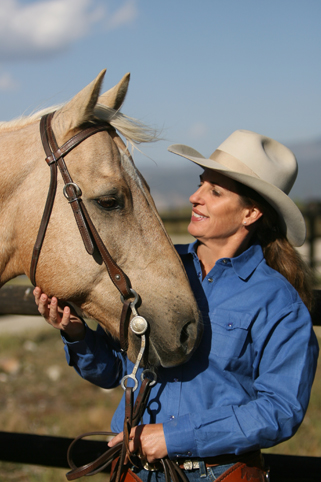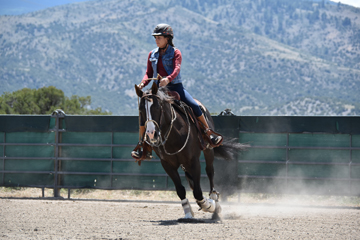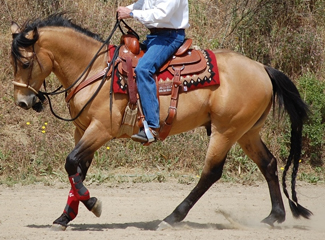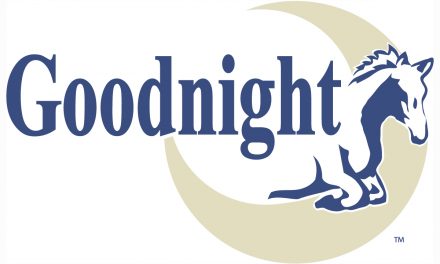Notes From Julie
 Although often the subject of debate, to me it’s a no-brainer—yes, you can teach people feel. I do it at every clinic. Now, if your question is, are some people naturally better at feel than others, the answer is also yes. I cannot give people that talent, but I can teach anyone what they should be feeling when they ride their horse.
Although often the subject of debate, to me it’s a no-brainer—yes, you can teach people feel. I do it at every clinic. Now, if your question is, are some people naturally better at feel than others, the answer is also yes. I cannot give people that talent, but I can teach anyone what they should be feeling when they ride their horse.
The illusive term of ‘feel’ can have many meanings: feeling your horse’s movement underneath you, having a delicate touch on the reins, knowing the exact moment to release, feeling trotting diagonals and canter leads without looking, feeling your horse prepare to make a movement before he makes it.
There are many factors involved in a rider having a good sense of feel. Skill level and coordination are important, but skill alone does not give a rider a good sense of feel. Experience is a factor, but sometimes advanced riders have poor feel. Knowledge is really important but sometimes, especially with horses, the harder you think about something, the worse your sense of feel. Certainly, good riding position and relaxed and fluid joints are a big part of feel.
Riding is a very intuitive sport and ‘feel’ is a very internal and intuitive thing. There are lots of highly skilled riders, with an excellent feel of the horse, that could not begin to explain to you verbally what they feel or do with their horse. Often riders with good feel know when they are doing something right, they just don’t know exactly why or how to explain it.
Although I am not a believer in right brained/left brained personality in horses (that’s anthropomorphic), I do see the right/left brain effect in the riders I teach all the time. Very left-brained people can be a challenge to teach ‘feel’ in horsemanship because they want to think through and analyze and justify and restate every piece of information. Just thinking that hard makes you tense, and if you are tense, you won’t feel it. Often, when it comes to riding, too much thinking definitely gets in the way.
However, I do believe that if you can get people in a correct and relaxed position on the horse, then explain to them what they should be feeling, even the most left-brained or rigid rider out there can learn to feel their horse. I’ve had great success teaching people to feel their horse’s hind legs in movement, to feel when is the right time to use their leg aids and how to feel diagonal and leads.
Feeling canters leads is not hard, either is feeling posting diagonals. But to do either, you have to know what you are feeling and have the self-discipline not to look. Looking with your eyes always interferes with your sense of feel. Instead, you need to think about how it feels for a few strides, make your decision, then look down if you need to verify. In time, you’ll trust your sense of feel and will not need to look down at all.
When the horse canters on the right lead, both his right hind and right fore legs are leading over the left legs (visa versa with the left lead)– he picks them up higher and reaches farther forward with those legs. Therefore his back will be slightly crooked underneath your seat, both front-to-back and side-to-side.
In your hips you’ll feel your inside hip in front of your outside hip, so if he is on the right lead, your right hip and leg will be in front of your left hip and leg. Because he is picking both leading legs up higher, you’ll also feel your weight shift to the outside, so if he is on the right lead, you’ll feel more weight in your left seat bone and left stirrup.
This unevenness that you feel in his back is important in setting your horse up for the correct lead, cueing for the canter and cueing for flying lead changes. As you go about cueing your horse for canter, you basically set your body into the canter position for the lead—your outside leg down and back (which tends to bring your inside hip and leg forward), your inside rein lifted (which shifts your weight into the outside stirrup). Then push with your seat in the canter motion (like you are pushing a swing), add a kissing sound as a voice cue, to cue the horse to canter.
Feeling posting diagonals is easy as well, if you can sit the trot and know what you should feel. There is a lot of vertical motion in your hips when you are sitting the trot, but there is also a lateral (or side-to-side) motion that correlates to the horse’s hind legs. If you can feel this lateral motion at the sitting trot, you can feel your diagonals.
When you feel your outside hip lift, it is the correct time to rise—that is when the horse is pushing off with his outside hind leg. First find the right-left feel in the sitting trot, then simply coordinate feeling your outside hip lift, with rising in your post. The coordination part is harder than the feeling part, once you know how to sit the trot.
There is great detail on all of this in volume 4 in my riding DVD series, Canter with Confidence, including cueing, feeling leads, dealing with lead problems, controlling the canter and lead changes. Also, volume 1, Balance and Rhythm in the saddle, helps you learn correct position and the rhythm and feel of each gait.
There’s much more to ‘feel’ than leads and diagonals; feel has a physical component (like what you do with your hands and contact on the bit) but there is also has an ethereal side to ‘feel’… sensing the horse’s moods, understanding his subtle communications, connecting with his psychology. When you find that connection, anything is possible with horses.
The physical side of feel is much easier to teach, but I’ve had good luck helping people connect better with their horses too. Knowledge and understanding are the keys.
Enjoy the ride!
By Julie Goodnight
Julie Goodnight takes on topics you want to know more about in her online training library—part of her ever-expanding Horse Master Academy (http://signin.juliegoodnight.com). For more thoughts from Julie, watch her Horse Master TV show each Monday and Saturday night on FamilyNet and RFD-TV (now with an added time at 2:30 pm ET on RFD-TV!).
Goodnight is proud to recommend Myler Bits, Nutramax Laboratories, Circle Y Saddles, Redmond Equine, The Equine Feed Oat Project, Spalding Fly Predators, Bucas Blankets and Millcreek Manure Spreaders. Goodnight is the spokesperson for the Certified Horsemanship Association. Explore her online training library and many training videos at http://tv.juliegoodnight.com





